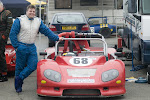Basically today I've just about finished splicing the engine management loom into the beastie. I think you'll agree it's looking a whole lot neater.
In no particular order I have
- Removed the existing starter solenoid and main fuseways (these are already on the car and not needed from the bike loom)
- Identified and spliced the switched and unswitched power supplies from the switchgear in the car to engine management loom.
- Identified the interlock cables (Pin 22) and tied these to permananetly to earth.
- Lenghtened and reorientated a few cables.
- Identified and removed all the wiring, relays and fuses in the bike loom that correspond to existing car systems such as lights, indicators etc.
- Fitted and spliced the alternator\rectifier circuits into the battery after the EFI switch.
- Identified and routed the engine kill circuits to the EFI cut off switch.
- Identified the Oil Pressure, Neutral, L & R indicators and main beam cables for the indicator lights in the clocks and got these ready ot be spliced into the car circuits.
- Removed the Fan power feed. The fan is controlled by the ecu via a relay as the ECU knows the coolant temp. As I already have a water pump\fan circuit in the racer I didn't want to power the fan from the ECU power supply (as it was in the original bike loom) so I looped my fan power supply over to the bike looms relay so that it can still be ECU controlled, but is actually powered by a seperate circuit.
- I looped the Fuel pump power supply from the bike loom relays via my seperate dashboard switch to ensure I meet the blue book requirements for a seperate switch.
- I spent at least 5 hours (on and off) staring at curcuit diagrams
- Fitted the high current circuit from the existing solenoid to the starter motor.
- Connected the clocks.
So after all that I was ready to to power it up and see if I had fried the ECU.
Ok! Kill switch on .... mmm no smell of burning. So ignition on and it runs the fuel pump for about 5 seconds and then it stops which is normal, plus the tacho does a full sweep to indicate that it is working properly too. Graeat Stuff!
Then I hit the start button, I think I can hear the injectors firing and the fuel pump runs continuously... so it looks like I've defeated the interlocks correctly. Huzzah!
I did have one problem. The CBR1000RR has a thing called a steering damper or HESD which is under ECU control. This I don't have and it's causing the ECU to display it's Malfunction Indicator light in the clocks and giving me a flash code of 51... "Steering Damper Open Circuit".
As the MIL light is bright red and also turned on by things like the low oil P switch I'd quite like to kill the damper based error so that I can see "real" engine based errors as they occur.
Now the ecu controls the damper using a two wire solenoid to open and close a restrictor valve (not unlike a normal ISCV in an ignition circuit I suspect) both cables connect to the ECU. According to the manual the damper test procedure is to measure the resistance of the solenoid. It should be between 6 & 8 ohms. so after a quick chat with my electron herder friends on CAM7 I cross connect the appropriate two wires with a 68 ohm resister and bingo the warning is gone. It seems that the diagnostic circuit is none to clever and anything other than an open circuit in roughly the right range will be fine.
Now when I short the low oil pressure line to earth the light comes on and I get the appropriate warnings, fab!
So now all that remains electrically is to
- Identify and connect the tacho feed to the DL1
- Ditto the coolant and oil temp feeds
- Connect the throttle position sensor to the DL1
- Connect the light circuits for indicators, main beam to the clocks so that the appropriate warning lights work.
- Fit the new Palm pilot display for lap timing and temp displays
- Bind everthing up and clip it into place.
After a day doing nothing but wiring I decided to do something mechanical and made up a little bracket to mount the clocks. I'd been pondering how to mount them for a while as they need to be a fairly long way from the plane of the old dashboard! In the end I decided to mount them on the steering column itself so that they rotate with the wheel, mainly because it was the simplest thing to do!
While playing with the clocks I also found that the CBR1000RR appears to have a configurable shift light. If you pwer them up holding the select button it seems you can set the rev limit\shift light point to be anywhere between 4500 and 12500 rpm... cool I wander what other tricks this thing has up it's sleeve.






